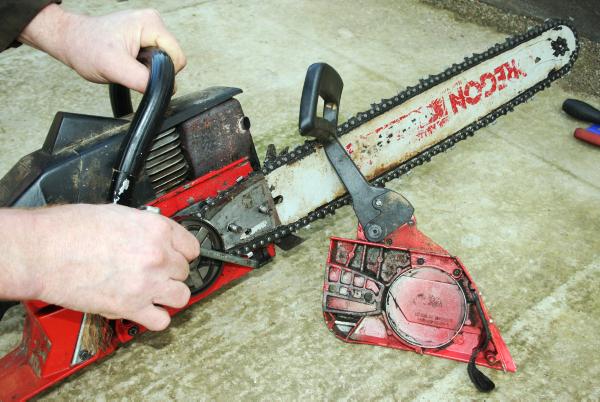The golden rule to working a chainsaw is if you find yourself leaning on it to make it cut, then you need to sharpen it. To sharpen the chain, do the left hand cutters first, lock the bar of the saw in a vice and put the chain brake on.
Ideally, what you want is to have both hands free. Each cutter has a mark on the top of it called a witness mark which serves two functions – firstly it indicates the sharpening angle and secondly it marks the end of the life of the chain when filed to this point.
Sharpening beyond the mark is dangerous. With too much sharpening, the cutters could possibly break off. This creates a risk of injury to the user or others close by.
Only sharpen in one direction with the file, inside to out. Otherwise the cutter will develop burrs on the outside and lose its edge very quickly again.
Basically, how quickly you have stopped determines how much you take off. Give each cutter two or three strokes/wipes of the file and you will get the full life out of the chain.
Oil
You need to use good-quality chainsaw chain oil, not waste oil. There is a reason it has been removed from your engine (high sulphur content and reduced lubrication qualities).
The oil needs to have the proper magnetic or cling qualities so it is not immediately flung from the chain at the nose. The viscosity needs to be correct for the saw – too thin and it will use too much oil, too thick and it will not lubricate the chain properly. The oil needs to be able to withstand very high temperatures.
Most saws below 50cc, which would be most farmers’ and weekend saws, have a fixed displacement chain lubrication pump. Those above 50cc would have an adjustable chain oil pump and are for semi-professional and professional use.
Daily inspection
Inspect all of the safety aspects of the saw each day. Check to see if the chain brake is operational before you start the saw. Check that the on/off switch is functioning. Check to see if the chain catcher is in place and intact, where the chain returns into the side cover.
Check that the throttle trigger lock is functioning; this is located on the topside of the handle, above the throttle trigger. Make sure that all guards are intact. Make sure the air intake is not blocked up with material – otherwise the saw may overheat. A blocked air intake will also restrict the air to the carburettor, making it run poorly.
Ensure you use a good-quality recommended two-stroke oil and mix it with the petrol at the right ratio. Air filter cleaning is a daily maintenance item on older saws but many modern saws are now fitted with cyclonic air cleaners which have reduced this to a weekly service item.
Starting
From cold, use the air purge device if fitted. This fills the fuel line and carburettor with fuel and purges out all the air, making the start much quicker. Now switch on and pull on the choke.
Pull the start cord until the engine fires only – it will not run on the choke. This is the critical part. If you miss the kick and proceed to pull one or two more times, with the choke out, you will flood the saw. So, after the kick, let off the choke and pull. It should start.
Starting from flooded
If you flood the chainsaw, you need to engage the chain brake, choke off and switch on. Lock the throttle in the full throttle position and proceed to pull as many times as it takes to start. Run the saw until it clears itself of all the heavy exhaust fumes from the flooded engine.
The manual
Finally, it is essential to read the manual, before work and especially if it’s been a while since you used the chainsaw. Take some time to familiarise yourself with the safety and maintenance aspects of your chainsaw.






 This is a subscriber-only article
This is a subscriber-only article




















SHARING OPTIONS: